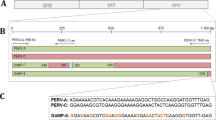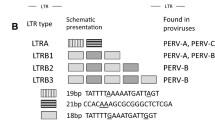Abstract
Animal donors such as pigs could provide an alternative source of organs for transplantation. However, the promise of xenotransplantation is offset by the possible public health risk of a cross-species infection1,2. All pigs contain several copies of porcine endogenous retroviruses (PERV)3,4, and at least three variants of PERV can infect human cell lines in vitro in co-culture, infectivity and pseudotyping experiments3,5,6,7. Thus, if xenotransplantation of pig tissues results in PERV viral replication, there is a risk of spreading and adaptation of this retrovirus to the human host. C-type retroviruses related to PERV are associated with malignancies of haematopoietic lineage cells in their natural hosts8. Here we show that pig pancreatic islets produce PERV and can infect human cells in culture. After transplantation into NOD/SCID (non-obese diabetic, severe combined immunodeficiency) mice, we detect ongoing viral expression and several tissue compartments become infected. This is the first evidence that PERV is transcriptionally active and infectious cross-species in vivo after transplantation of pig tissues. These results show that a concern for PERV infection risk associated with pig islet xenotransplantation in immunosuppressed human patients may be justified.


Similar content being viewed by others
References
Chapman, L. E. et al. Xenotransplantation and xenogeneic infections. N. Eng. J. Med. 333, 1498–1501 (1995).
Stoye, J. P. Xenotransplantation. Proviruses pose potential problems. Nature 386, 126–127 ( 1997).
Patience, C., Takeuchi, Y. & Weiss, R. A. Infection of human cells by an endogenous retrovirus of pigs. Nature Med. 3, 282– 286 (1997).
Akiyoshi, D. E. et al. Identification of a full-length cDNA for an endogenous retrovirus of miniature swine. J. Virol. 72, 4503– 4507 (1998).
Le Tissier, P., Stoye, J. P., Takeuchi, Y., Patience, C. & Weiss, R. A. Two sets of human-tropic pig retrovirus. Nature 389, 681–682 (1997).
Takeuchi, Y. et al. Host range and interference studies of three classes of pig endogenous retrovirus. J. Virol. 72, 9986 –9991 (1998).
Wilson, C. A. et al. Type C retrovirus released from porcine primary peripheral blood mononuclear cells infects human cells. J. Virol. 72, 3082–3087 (1998).
Toth, S. R., Onions, D. E. & Jarrett, O. Histopathological and hematological findings in myeloid leukemia induced by a new feline leukemia virus isolate. Vet. Pathol. 23, 462–470 ( 1986).
Hesselton, R. M. et al. High levels of human peripheral blood mononuclear cell engraftment and enhanced susceptibility to human immunodeficiency virus type 1 infection in NOD/LtSz-scid/scid mice. J. Infect. Dis. 172, 974–982 (1995).
McCune, J. M. et al. The SCID-hu mouse: murine model for the analysis of human hematolymphoid differentiation and function. Science 241, 1632–1639 (1988).
Crisa, L. et al. Human cord blood progenitors sustain thymic T-cell development and a novel form of angiogenesis. Blood 94, 3928–3940 (1999).
Miyoshi, H., Smith, K. A., Mosier, D. E., Verma, I. M. & Torbett, B. E. Transduction of human CD34+ cells that mediate long-term engraftment of NOD/SCID mice by HIV vectors. Science 283, 682–686 ( 1999).
Heneine, W. et al. No evidence of infection with porcine endogenous retrovirus in recipients of porcine islet-cell xenografts. Lancet 352, 695–699 (1998); erratum Lancet 352, 1478 ( 1998).
Paradis, K. et al. Search for cross-species transmission of porcine endogenous retrovirus in patients treated with living pig tissue. Science 285, 1236–1241 ( 1999).
Levy, J. A. Xenotropic viruses: murine leukemia viruses associated with NIH Swiss, NZB, and other mouse strains. Science 182, 1151 –1153 (1973).
Lamont, C. et al. Characterization of endogenous and recombinant proviral elements of a highly tumorigenic AKR cell line. J. Virol. 65 , 4619–4628 (1991).
Patience, C. et al. No evidence of pig DNA or retroviral infection in patients with short-term extracorporeal connection to pig kidneys. Lancet 352, 699–701 ( 1998).
Wilson, C A., Wong, S., VanBrocklin, M. & Federspiel, M. J. Extended analysis of the in vitro tropism of porcine endogenous retrovirus. J. Virol. 74, 49–56 (2000).
Sandrin, M. S. & McKenzie, I. F. Recent advances in xenotransplantation. Curr. Opin. Immunol. 11, 527–531 (1999).
Weiss, R. A. Transgenic pigs and virus adaptation. Nature 391, 327–328 (1998).
Beattie, G. M. & Hayek, A. Outcome of human fetal pancreatic transplants according to implantation site. Transpl. Proc. 26, 3299 (1994).
Liu, X. et al. Prolongation of porcine islet allograft survival. Transpl. Proc. 29, 768–769 ( 1997).
Acknowledgements
We thank J. Elder, A. Pelletier, J. Coffin, J. Stoye and G. Langford for helpful discussions, and D. Stablein for expert statistical advice. We thank I. Mychkovsky and T. Gladden for assistance in mRNA/DNA purification, T. Gilmore, J. Ansite and D. Scharpe for assistance in purification of pig islets, and L. Crisa, P. Hildbrand and O. Schussler for help with mouse surgery. We thank R. Ingram and M. Pierschbacher for the RGD collagen templates for transplantation. D.R.S, B.C.G., F.S.F., B.E.T. and this work are supported by an NIH/NIAID grant. L.J.W.L. is supported by a Juvenile Diabetes Foundation International (JDFI) fellowship.
Author information
Authors and Affiliations
Corresponding author
Rights and permissions
About this article
Cite this article
van der Laan, L., Lockey, C., Griffeth, B. et al. Infection by porcine endogenous retrovirus after islet xenotransplantation in SCID mice. Nature 407, 90–94 (2000). https://doi.org/10.1038/35024089
Received:
Accepted:
Issue Date:
DOI: https://doi.org/10.1038/35024089
- Springer Nature Limited
This article is cited by
-
First pig kidney transplant in a person: what it means for the future
Nature (2024)
-
Screening pigs for xenotransplantation in China: investigation of porcine endogenous retrovirus in Diannan small-eared pigs
Virus Genes (2020)
-
Why was PERV not transmitted during preclinical and clinical xenotransplantation trials and after inoculation of animals?
Retrovirology (2018)
-
Notochordal cell matrix as a bioactive lubricant for the osteoarthritic joint
Scientific Reports (2018)
-
Regenerative medicine and cell-based approaches to restore pancreatic function
Nature Reviews Gastroenterology & Hepatology (2017)





